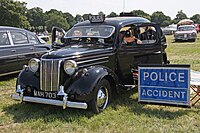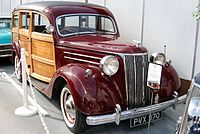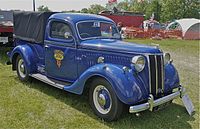Ford Pilot
| Ford Pilot E71A | |
|---|---|
 Ford V8 Pilot saloon | |
| Overview | |
| Manufacturer | Ford UK |
| Also called | Ford V8 Pilot [1] |
| Production | 1947–51 |
| Assembly | United Kingdom Australia [2] |
| Body and chassis | |
| Class | Mid-size / Large family car (D) |
| Body style | 4-door saloon 4-door estate car 2-door pick-up 2-door coupe utility [3] |
| Powertrain | |
| Engine | 2.2 L V-8 3.6 L V-8 |
| Dimensions | |
| Wheelbase | 108.25 in (2,750 mm)[4] |
| Length | 175 in (4,445 mm) |
| Width | 69.5 in (1,765 mm) |
| Curb weight | 3,200 lb (1,500 kg) |
| Chronology | |
| Predecessor | Ford Model 62 [5] |
| Successor | Ford Zephyr |
The Ford Pilot Model E71A is a medium-sized car that was built by Ford UK from August 1947 to 1951.[6] It was effectively replaced in 1951 with the launch of Ford UK's Zephyr Six and Consul models, though V8 Pilots were still offered for sale, being gradually withdrawn during that year. In its production run 22,155 cars were made.
Engine and running gear
The Pilot was the first large post-war British Ford. It was based on the pre-war 22 bhp Model 62 chassis, and was initially offered with the 2227 cc side-valve engine from the 1939 model.[6] These first cars were built with Canadian Ford surplus engines from wartime production of Bren gun carriers.
This engine was soon replaced: most Pilots were built with a more powerful 3622 cc, 90 hp (67 kW) side-valve V8 engine with a stroke of 92.25 mm (3.6 in) and bore of 79 mm (3.1 in) and fed by a single Solex carburettor. This is essentially the same "low water pump, 21 stud" engine as fitted to the North American 1937–38 models, but with an additional frost plug hole cast into the rear of each cylinder bank. This engine was also used in Thames trucks.
The gears are changed by means of a gear lever on the steering column. The gearbox has three forward ratios and one reverse. Steering uses a form of worm and roller mechanism called a Marles steering box, which has an "hour-glass cam and a double roller".[7] The car was considered rather old-fashioned even when new, but its front brakes are hydraulically operated.[6] The rear brakes are cable-operated.
The Pilot was built with 6-volt electrics.
Most Pilots were four-door saloons, but Estate and pick-up versions were built, the latter for export only. The front windscreen can be opened for ventilation, pivoted about a top hinge. Production ended in 1951 when Ford replaced the Pilot with the Zephyr.
Like other Fords of its era, the Pilot has vacuum-driven wipers powered from the engine manifold. As a result they tend to work much more slowly or even stop when full throttle is used under load. The car was reputed to accelerate from 0 to 60 miles per hour (97 km/h) in 21 seconds, have a top speed of 80 mph (130 km/h), and return 18 miles per imperial gallon (16 L/100 km; 15 mpg‑US).
-
Ford V8 Pilot saloon police car, with windscreen open
-
Ford V8 Pilot estate
-
Ford V8 Pilot pick-up
Australian assembly

Ford Australia introduced the Pilot to Australia in 1949, importing the model in both fully assembled and semi-knocked down form.[2] Initially dearer than the Canadian Ford Custom V8, its price was gradually reduced in relative terms until it was cheaper than the Custom.[2] A coupe utility variant was also produced.[3]
Motor sport
The Pilot achieved some sporting success. Ken Wharton drove one to victory in the 1950 Tulip Rally[8] and in the 1950 Lisbon International Rally.[9]
See also
- Ford Prefect – the intermediate family saloon
- Ford Anglia – the cheapest Ford of the range
References
- ^ Ford V8 Pilot advertisement, Australian Monthly Motor Manual, March 1950
- ^ a b c Darwin, Norm (1986). The History of Ford in Australia. Newstead: Eddie Ford Publications. p. 122. ISBN 978-0959228724.
- ^ a b "1949 Ford Pilot Sedan". Restored Cars. No. 37. July–August 2016. pp. 45–47.
- ^ Culshaw, David; Horrobin, David (1974). Complete Catalogue of British Cars. London: Macmillan. ISBN 0-333-16689-2.
- ^ Geoghegan, Simon. "Ford V8 Pilot". Simon Cars. Retrieved 2 April 2015.
- ^ a b c Gloor, Roger (2007). Alle Autos der 50er Jahre 1945–1960 (1. ed.). Stuttgart: Motorbuch Verlag. ISBN 978-3-613-02808-1.
- ^ Merritt, Peter (August 1961). "When the worm turns...or the pinion rotates...". Practical Motorist. 7. 84: 1278–1279.
- ^ "Ford triumph in the Tulip Rally". The Autocar. 28 April 1950. p. 490.
- ^ "Lisbon International Rally, June 1950'". Team Dan. Retrieved 1 April 2015.



